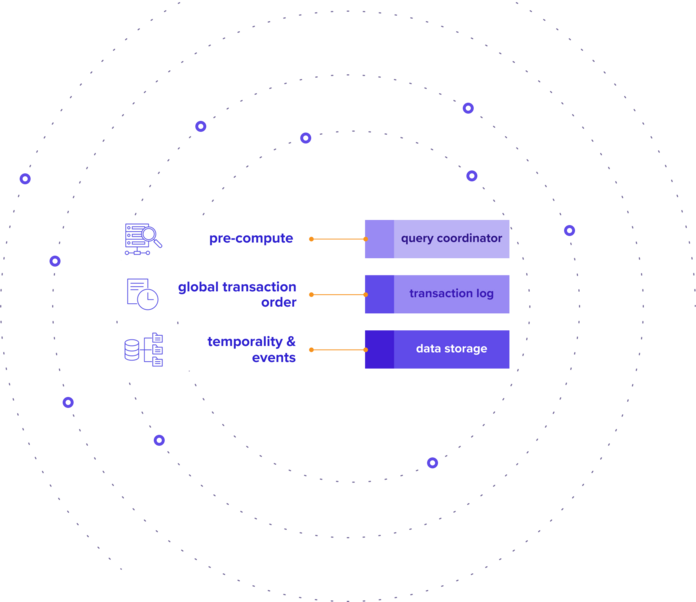Distributed Transaction Engine
Seamlessly deliver strong consistency, low latency, and high availability with zero engineering operations — ensuring applications perform flawlessly across regions and the globe




Introduction to Fauna
Explore Fauna in 2 minutes: Explore Fauna's robust features in 2 minutes: API delivery model, automatic distribution & replication, document flexibility with relational consistency & querying power, modern and identity-driven security, native multi-tenancy, and more.

Distributed Transaction Engine
Built on the Calvin protocol, Fauna’s Distributed Transaction Engine enables low-latency, high-concurrency synchronous replication across multiple locations, ensuring the strongest level of consistency. With a load balancer that auto-routes to the nearest active replica, Fauna delivers high availability and resilience, while independently scalable service layers ensure continuous low latency as your applications grow. Meanwhile, Fauna's serverless delivery abstracts traditional operational tasks such as sharding, scaling, and provisioning, offering a seamless experience for developers.
Strong Consistency Across Regions
Fauna ensures data integrity and consistency, making it ideal for applications where accuracy and reliability are paramount, even in geographically dispersed settings. This scalable, strong transaction support with the strongest ACID guarantees to provide strict serializability across distant regions.
“Fauna is the reason we are still in business. There is not enough good stuff I can say about the folks over there.” Read case study

Alice
From Wonderland


Low Latency Everywhere
Fauna’s architecture ensures low-latency transactions from anywhere in the world. Built-in clustering, replication, partitioning, and redundancy prevent downtime and data loss, offer high availability without single points of failure, and ensure real-time responsiveness and uninterrupted user experiences for the most demanding applications.
High Availability By-Default
Fauna’s multi-region distributed architecture creates a robust infrastructure that guarantees uninterrupted access to your data and applications. With no single points of failure, Fauna ensures that your mission-critical systems remain online and reliable, even in challenging circumstances.


Streamlined Data Residency Compliance
Fauna's architecture is perfect for data residency-compliant applications. Our intelligent routing system ensures data is stored and processed according to regional regulations while optimizing access for low-latency, responsive global experiences.

Capabilities


Multi-Active Reads & Writes
Fauna delivers multi-active reads and writes, allowing simultaneous data access and modifications across multiple regions without compromising strong consistency ACID transactionality or performance. This capability ensures that applications can deliver low-latency experiences to users globally, supporting real-time data synchronization and high availability.


Intelligent Routing
Fauna’s intelligent routing capabilities automatically direct your queries to the optimal data nodes, ensuring the best possible performance. This intelligent routing mechanism reduces latency and enhances the overall user experience by ensuring data access is always fast and efficient, regardless of where your users are located - without any engineering operations.


Automatic Consistency, Reliability, & Data Compliance
Fauna’s DTE provides strictly serializable transaction isolation by-default, ensuring that all reads and writes are consistent across three replicasand reliable. Fauna’s ACID transactions guarantee that your applications can always trust the integrity of their data. Meanwhile, Fauna’s concept of Region Groups gives you control over where your data resides, which you can use to comply with data locality regulations, such as the General Data Protection Regulation (GDPR).


High Availability By-Default
Fauna’s DTE reimagines how a database stores, replicates, and processes data at high scale and low latency. The unique new Calvin-based DTE ensures low latency, high concurrency synchronous replication over 3 locations for high resilience & best in class data consistency while providing multi-active services & auto-routing for always-on HA. automatically replicates data to multiple locations to ensure data can be served even in the event of a full regional outage. Built-in clustering, replication, partitioning, and redundancy prevent downtime and data loss, offer high availability without single points of failure, and ensure real-time responsiveness and uninterrupted user experiences for the most demanding applications.


Get started building with Fauna
Explore resources that can help get you up and running in minutes.
Multi-tenant SaaS Sample App
Learn how to build a multi-tenant, multi-region SaaS app without ops using Fauna and AWS
BUILD THE SAMPLE APP
New to Fauna Query Language?
This guide can help you get started with FQL in under 10 minutes.
READ MORE
Workshops
Learn how to build complete applications using technology like AWS, Cloudflare, and more.
EXPLORE THE WORKSHOPS
FAQs
Have other questions? Feel free to contact us, or browse our documentation.

Get started building with Fauna
Explore resources that can help get you up and running in minutes.
Multi-tenant SaaS Sample App
Learn how to build a multi-tenant, multi-region SaaS app without ops using Fauna and AWS
BUILD THE SAMPLE APP
New to Fauna Query Language?
This guide can help you get started with FQL in under 10 minutes.
READ MORE
Workshops
Learn how to build complete applications using technology like AWS, Cloudflare, and more.
EXPLORE THE WORKSHOPS
FAQs
